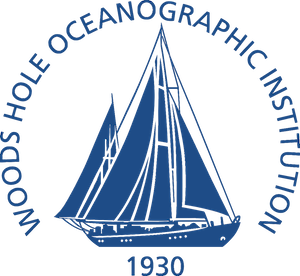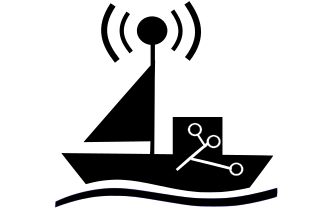Related Research Articles

École Centrale de Nantes, or Centrale Nantes, is a grande école - a French engineering school - established in 1919 under the name of Institut Polytechnique de l'Ouest. It delivers Graduate, Master, and PhD Programmes based on the latest scientific and technological developments and the best management practices.

The Woods Hole Oceanographic Institution is a private, nonprofit research and higher education facility dedicated to the study of marine science and engineering.

A remotely operated underwater vehicle is a tethered underwater mobile device, also commonly called an underwater robot.

The Moss Landing Marine Laboratories (MLML) is a multi-campus marine research consortium of the California State University System, headquartered at Moss Landing, California.
The National Ocean Service (NOS) is an office within the U.S. Department of Commerce National Oceanic and Atmospheric Administration (NOAA). It is responsible for preserving and enhancing the nation's coastal resources and ecosystems along the 95,000 miles (153,000 km) of shoreline bordering 3,500,000 square miles (9,100,000 km2) of coastal, Great Lakes, and ocean waters. Its mission is to "provide science-based solutions through collaborative partnerships to address evolving economic, environmental, and social pressures on our oceans and coasts." The office works closely with many partnered agencies to ensure that ocean and coastal areas are safe, healthy, and productive. National Ocean Service scientists, natural resource managers, and specialists work to ensure safe and efficient marine transportation, promote innovative solutions for the protection of coastal communities, and to conserve marine and coastal places. It is a scientific and technical organization of approximately 1,700 scientists, natural resource managers, and specialists in many different fields. The National Ocean Service was previously known as the National Ocean Survey until it was renamed in 1983.

The National Oceanography Centre Southampton (NOCS) is a centre for research, teaching, and technology development in Ocean and Earth science. NOCS was created in 1995 jointly between the University of Southampton and the UK Natural Environment Research Council and is located within the port of Southampton at a purpose-built dockside campus with modern facilities. In 2010 the university and NERC components demerged, and the NERC-managed component became the National Oceanography Centre. The two components of NOCS continue close collaboration through the jointly run Graduate School, shared research facilities and laboratories, complementary research groups, and many joint research grants and publications. The university component “Ocean and Earth Science, National Oceanography Centre Southampton” (OES) is part of the Faculty of Environmental and Life Sciences, (FELS). It was ranked 46th in the world for Earth and Marine Sciences by the QS World University Rankings in 2019.

Oceanic and Atmospheric Research (OAR) is a division of the National Oceanic and Atmospheric Administration (NOAA). OAR is also referred to as NOAA Research.
The Pacific Marine Environmental Laboratory (PMEL) is a federal laboratory in the National Oceanic and Atmospheric Administration (NOAA) Office of Oceanic and Atmospheric Research (OAR). It is one of seven NOAA Research Laboratories (RLs). The PMEL is split across two sites in the Pacific Northwest, in Seattle, Washington and Newport, Oregon.
The National Oceanography Centre (NOC) is a marine science research and technology institution based on two sites in Southampton and Liverpool, United Kingdom. It is the UK’s largest institution for integrated sea level science, coastal and deep ocean research and technology development.

Unmanned surface vehicles (USVs), also known as unmanned surface vessels, autonomous surface vehicles (ASVs) in some cases, uncrewed surface vessels (USVs), or colloquially drone ships, or robot boats, are boats or ships that operate on the surface of the water without a crew. USVs operate with various levels of autonomy, from remote control to fully autonomous.

The University of Science and Technology (UST) is a group of public universities and research institutions in Seoul, Suwon, Changwon, Ansan, Seongnam and Daejeon, in South Korea. The UST was established in 2003 by the Ministry of Science, ICT and Future Planning as the nation’s graduate school specializing in science and engineering education and research. The UST runs only a graduate school. Creating the new driving force for growth would play a major role in leading national growth in the new century. The South Korean government established the UST to produce professionals in the field of combined technologies, thought of as one of the most important criteria for creating the driving force for South Korea's national growth. Today, UST continues to develop itself into a major research university.

The Scottish Association for Marine Science (SAMS) is one of Europe's leading marine science research organisations, one of the oldest oceanographic organisations in the world and is Scotland's largest and oldest independent marine science organisation.

Partnerships in Environmental Management for the Seas of East Asia (PEMSEA) is a regional partnership programme implemented by the United Nations Development Programme (UNDP) and executed by the United Nations Office for Project Services (UNOPS). The project, started in 1994, was originally known as Prevention and Management of Marine Pollution in the East Asian Seas (SDS-SEA).
RV Onnuri is one of the Korean Ocean Research and Development Institute (KORDI)'s research vessels. She was built in Bergen, Norway in 1991 by Mjellem & Karlsen Verft AS and designed by Skipsteknisk AS. She has been used to supply Korea's Antarctic research station as well as undertaking oceanographic research in the Pacific Ocean. She has a sister ship, Eardo, also operated by KORDI.

In-Young Ahn is a South Korean scientist. She is known for being the first South Korean woman to visit Antarctica and the first Asian woman to become an Antarctic station leader. She is a benthic ecologist and is currently working as a principal research scientist for Korea Polar Research Institute.

Hong Kum Lee is an Antarctic researcher, best known for work as the Director General of the Korea Polar Research Institute (KOPRI).
Saildrone, Inc. is a United States company based in Alameda, California, that designs, manufacturers, and operates a fleet of unmanned/uncrewed surface vehicles (USVs), or ocean drones, known as "saildrones". The company was founded by engineer Richard Jenkins in 2012.
References
- ↑ "KIOST". KIOST.
- ↑ "Functions & History". kiost.ac.kr.
- ↑ Kieron Monks, Giant six-legged robot crab to walk the ocean floor, Cnn.com, 1 April 2014
- ↑ Sofia Lotto Persio, North Korea soldiers are being treated for radiation exposure after nuclear test: report, Newsweek.com, 11 January 2017
- ↑ New RAMA partnership between PMEL and the Korea Institute of Ocean Science and Technology, Pmel.noaa.gov, 6 July 2017
- ↑ Josh Smith, 'Treasure ship' claim raises eyebrows in South Korea, Reuters.com, 19 July 2018
- ↑ "Challenger Glider Mission — Academic Partners". Rutgers University.
- ↑ "About — International Partners: Korea Institute of Ocean Science and Technology (KIOST)". Virginia Institute of Marine Science.
- ↑ "About PEMSEA — Non-country partners: KIOST". PEMSEA.